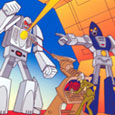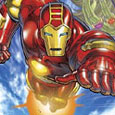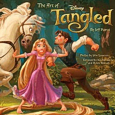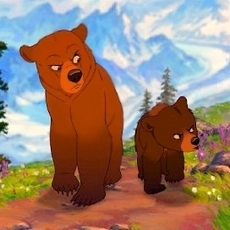Hanna-Barbera (1984), Warner Archive (May 17, 2011), 1 disc, 110 mins, 4:3 ratio, Dolby Digital 1.0, Not Rated , Retail: $14.95
Storyboard:
Renegades from the planet Gobotron come to Earth to force the population there to aid them in their quest of taking over their home world. Fortunately, The Guardians of Gobotron are ready to assist humans is resisting the evil robots.
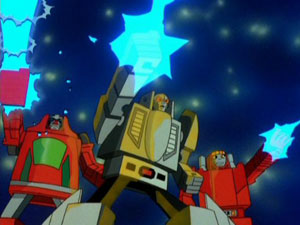
The Sweatbox Review:
Life in the 1980s meant cartoon watchers had their choice of animated series to watch— but most of them seemed to be toy tie-ins. By the mid-1980s (much aided by decreasing television regulation that had prevented such shows previously), kids were watching such popular shows as G.I. Joe, He-Man, and of course Transformers. Never had there been a more ludicrous premise for a show than Transformers, a tale of alien shape-changing robots that carry out their battles on planet Earth. Still, there was something pretty cool about seeing giant robots transform into various vehicles, which served the toy line much better than it served the plots in the cartoon. That cartoon, nevertheless, was extremely popular and begat a successful comic book that managed to even outlast the original toy line by a few years. Transformers has been immortalized in popular culture, serving as a touchstone for Generation X’ers around the world, a high point of their childhoods.

And then there was Challenge Of The Gobots. Like Transformers, the Gobots were adapted for the North American market by an American toy maker, licensed from shape changing robot toys produced in Japan. Tonka introduced the Gobots in 1984 (based on Japan’s “Machine Robo” line), the same year that Transformers toys hit the market from Hasbro (Habro has since bought Tonka). Back in the day, as I recall, the Gobots were seen as inferior, and possibly even knockoffs, though I’m not sure which actually came out in Japan first. The Gobots had the multi-pronged problem of less cool advertising, lamer transforming capabilities, and even lamer names. While the Transformers could boast the likes of Optimus Prime and Starscream, the Gobots countered with Tank and Scooter. That is just sad.
The two toy lines competed on television as well as toy shelves, with their respective debuts coming in the form of miniseries in 1984. For the Gobots, Tonka partnered with Hanna-Barbera to create a five-part series that was shown in syndication the week of October 29, while the regular series did not come out until the following September. (This was a full year after Transformers aired its first full season of thirteen episodes, which likely accounts for the perception of Gobots coming late to the party). The five-part Challenge Of The Gobots miniseries sets up the premise of the show and readies it for its next incarnation as a full-fledged series.
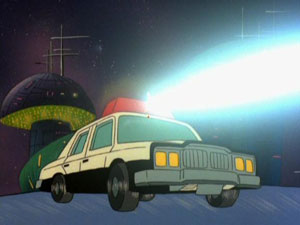
The mechanical planet of Gobotron (yikes, that’s an awful name) is populated by large robots consisting of two opposing factions. The Guardians maintain peaceful ways, but they are opposed by the Renegades, mostly due to the thirst for power exhibited by their leader Cy-Kill. As the miniseries opens, Cy-Kill is plotting a revolutionary war that would end with him taking over the planet. The big battle is set to begin, but Cy-Kill takes two of his most trusted soldiers and they steal the Astro Beam, which will allow them to travel to Earth. There, they plan to create a weapon that will guarantee the Renegades’ victory. The Gobotron authorities desperately try to stop them (with one Gobot ridiculously changing into an Earth police vehicle that shoots a laser from its flashing lights), but Cy-Kill and his cronies, Crasher and Cop-Tur, manage to escape (all the while, the music composer is amazingly doing his riff on the Superman theme).

Meanwhile, a NASA pilot named Matt Hunter is flying in space with two teenagers (Rick and A.J.) in Earth orbit, none of them wearing spacesuits. They encounter Cy-Kill’s spacecraft, and end up crashing to Earth, leaving them in heavy trouble with Hunter’s NASA superiors. Among Hunter’s harshest critics is NASA scientist Dr. Zebidiah Braxis (enthusiastically voiced by Rene Auberjenois), a miserable jerk who to no one’s surprise turns out to be Cy-Kill’s accomplice on Earth. Following the crash, Hunter and the kids are caught in the crossfire between Cy-Kill’s team and the pursuing Guardians, led by Leader-1, who is joined by Turbo and Scooter. The outcome of the skirmish is that the Guardians team with Hunter and the kids, even as Turbo is badly injured.

By helping Turbo, despite placing themselves into further trouble with the authorities (who know nothing of the alien robot war), Hunter and the kids prove themselves to be valuable allies to the Guardians. Cy-Kill continues his machinations elsewhere, acquiring a dangerous element that will help him to assert his will over the people of earth. Over the course of the story, Earth’s people become enslaved, destructive weapons are built, a Russian lady scientist joins the good guys, and numerous battles ensue. These battles, naturally, show off the abilities of the robots to change into various forms, such a Cy-Kill’s cycle form, Cop-Tur’s helicopter (not to mention his propeller arm of death), Scooter’s… uh, Scooter, and some fancy cars courtesy of Crasher and Turbo.

It’s a load of hokum, of course, though no more absurd than the competing Transformers franchise. Which show is superior may be debatable, and as I’ve yet to see a single episode of Transformers, I’m obviously no judge. I can tell you, though, that Challenge Of The Gobots is one cheesy show. The plot is simplistic, characters are boring (aside from the scenery-chewing Braxis), the robot vehicle forms are obvious and uninspired, and the animation is clumsy to say the least. Designs are also poor, being too detailed for cheap animation, and lacking in polish; this is particularly true of the humans, which appear to be drawn by art school dropouts. And what was the rationale behind the color choices for the main three Guardians? Two of them are the same shade of red, and the other is grey. Not a good design decision, there.
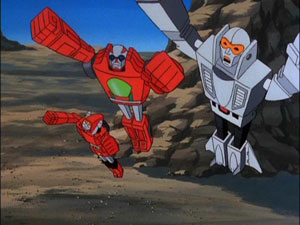
The question, though, is it fun to watch? Actually, while I can’t say I’m dying to see more, it is fairly watchable. You can’t deny the appeal of the concept, ridiculous though it may be. Right from the start, you either decide to just go with it, or tune out entirely. Having no nostalgic attachment to the show, it’s not one I would necessarily look forward to revisiting; but I did enjoy watching it with my little guy, who was decidedly enthusiastic. And that’s the bottom line— it’s a dandy show for little kids who love robots and a little action.
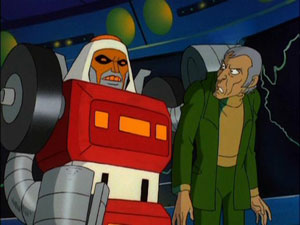
Is This Thing Loaded?
There are no actual extras on this release form Warner Archive, but I will give them props for providing the bumpers for each episode. However, after the first episode, we lose the audio for these, which should have been pretty easy to fix by splicing in the exact same bumpers from the first episode.
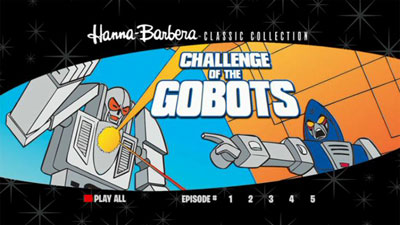
You can select to play the whole miniseries, which runs less than two hours, or choose an individual episode (though you certainly need to watch them in order). Unlike earlier Archive releases, chapter stops are not simply every ten minutes; they actually do begin either with the episode’s opening or the bumpers.
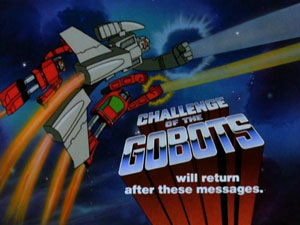
Case Study:
Standard keepcase. As an aside, I thought it was funny that they kept Cy-Kill off the front cover. That’s one horrible character design, some sort of cross between an exploded motorbike and Fred Flintstone. Seriously, what’s with the 5 o’clock shadow? I guess that, aside from it being a Hanna-Barbera staple, it was also an Eighties thing. You may still see Cy-Kill in all his Miami Vice glory on the back cover, which also gives episode titles.
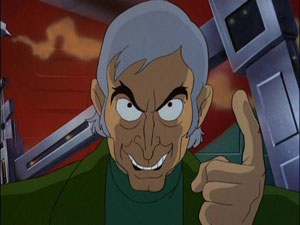
Ink And Paint:
The show may be silly, but the transfer rocks. Warner actually did a remaster for this show, and it shines. Colors are bright and solid with good saturation, with a steadiness I’m tempted to call almost perfect. The cheapness of the animation amounts for most problems that one could pick at. The care taken here is a pleasant surprise.

Scratch Tracks:
The mono sound certainly has no real chance to impress, but it is clear and certainly suits the material.

Final Cut:
Fans will be delighted with this release, with the only real nitpick being the loss of audio on most of the bumpers. Older existing fans should enjoy revisiting the show, while young ones will find it as engaging as other kids did back in the 1980s. No doubt that solid sales on this release can lead to a release of the full Gobots series. If so, my boy and I will be ready.
 | ||
 |


